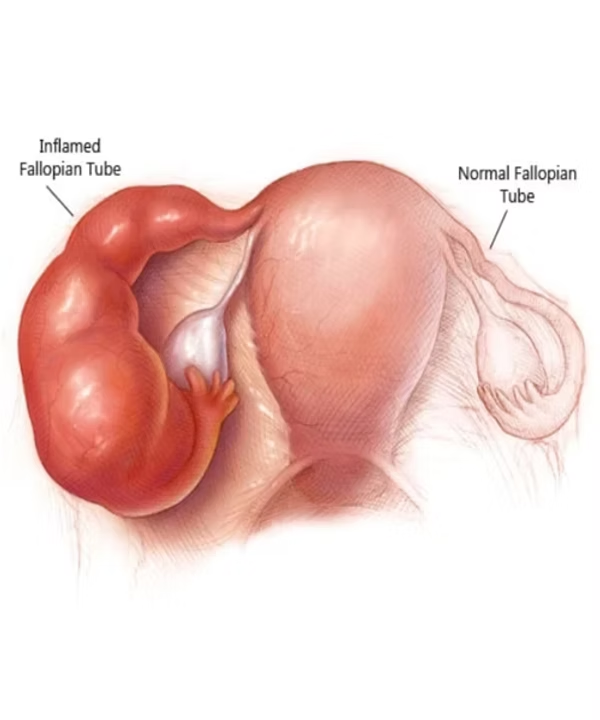
Tubal disease is a condition that affects the fallopian tubes, which play a vital role in female fertility. These slender tubes connect the ovaries to the uterus, facilitating the transport of eggs and sperm, as well as the fertilized embryo to the uterus for implantation. When the fallopian tubes are damaged or blocked, it can lead to infertility or increase the risk of ectopic pregnancy, where a fertilized egg implants outside the uterus.
At Patteds Fertility and Research Centre, we understand how critical the fallopian tubes are for conception and strive to offer advanced diagnostics and treatments for women experiencing tubal diseases. In this article, we will explore the causes, types, symptoms, diagnosis, and treatment options for tubal disease, as well as its impact on fertility.
Understanding Tubal Disease: What is it ?
Tubal disease refers to any condition that causes damage, scarring, or blockage of the fallopian tubes. The fallopian tubes must remain open and healthy for natural conception to occur. However, various factors can impair their function, preventing the egg and sperm from meeting or the embryo from reaching the uterus.
Tubal disease can vary in severity:
-
Partial blockage: Where the tube is narrowed but not completely closed, possibly allowing some movement of eggs and sperm.
Complete blockage: Where the tube is entirely closed, preventing conception.
Hydrosalpinx: A condition where the fallopian tube is swollen and filled with fluid, often due to infection or inflammation.
Several factors can lead to tubal disease, including:
-
Pelvic Inflammatory Disease (PID): A common cause of tubal damage, PID is an infection of the reproductive organs, often resulting from sexually transmitted infections (STIs) like chlamydia or gonorrhea. If untreated, PID can cause scarring and blockages in the fallopian tubes.
-
Endometriosis: In this condition, tissue similar to the lining of the uterus grows outside it, sometimes affecting the fallopian tubes and causing inflammation, scarring, or adhesions that obstruct their function.
-
Ectopic Pregnancy: A previous ectopic pregnancy can damage the fallopian tubes, increasing the risk of future tubal problems.
-
Surgery or Trauma: Pelvic or abdominal surgeries, such as appendectomy or cesarean delivery, may lead to adhesions (bands of scar tissue) that impair the fallopian tubes.
-
Tuberculosis (TB): In regions where tuberculosis is prevalent, genital TB can cause significant damage to the fallopian tubes.
-
Congenital Abnormalities: Rarely, some women are born with abnormalities in the structure of their fallopian tubes, which can affect their function.
Symptoms of Tubal Disease
In many cases, tubal disease may not present obvious symptoms until a woman experiences difficulties conceiving or complications like an ectopic pregnancy. However, some signs that could indicate a problem include:
-
Chronic pelvic pain or discomfort
-
Painful periods or intercourse
-
Irregular menstrual cycles
-
Symptoms of an underlying condition, such as PID (e.g., fever, unusual vaginal discharge).
Because tubal disease often goes undetected until infertility is diagnosed, it is essential for women experiencing difficulties in conceiving to seek a thorough evaluation.
Diagnosis of Tubal Disease
At Patteds Fertility and Research Centre, we use state-of-the-art diagnostic techniques to accurately assess the condition of the fallopian tubes. Common diagnostic methods include:
-
Hysterosalpingography (HSG): An X-ray procedure that uses contrast dye to evaluate whether the fallopian tubes are open and assess the shape of the uterine cavity.
-
Sonohysterography: A specialized ultrasound that uses saline solution to provide detailed images of the uterus and fallopian tubes.
-
Laparoscopy: A minimally invasive surgical procedure where a small camera is inserted into the abdomen to visually inspect the fallopian tubes, uterus, and surrounding structures. It can also detect and treat conditions like endometriosis or adhesions.
-
Blood Tests: Tests for infections or conditions like tuberculosis may be conducted if clinically indicated.
Impact of Tubal Disease on Fertility
-
Infertility: Prevents the egg and sperm from meeting.
Ectopic Pregnancy: A fertilized egg may implant in a damaged or partially blocked fallopian tube instead of the uterus.
-
Recurrent Pregnancy Loss: Poor tubal function may lead to miscarriages.
Treatment Options for Tubal Disease
-
Medications: For infections like PID or tuberculosis, antibiotics or other appropriate medications can prevent further damage to the fallopian tubes.
-
Surgical Intervention:
-
Adhesiolysis: Surgery to remove adhesions caused by endometriosis or previous surgeries.
-
Tuboplasty: A surgical procedure to open or repair blocked or damaged fallopian tubes.
-
Fertility Treatments: If surgical repair is not feasible or unsuccessful, assisted reproductive technologies (ART) such as in vitro fertilization (IVF) are often recommended. IVF bypasses the fallopian tubes, as eggs are retrieved from the ovaries and fertilized in a laboratory before being transferred directly into the uterus.
-
Treatment for Hydrosalpinx: A hydrosalpinx can reduce the success rates of IVF. In such cases, the affected tube may need to be removed or sealed before IVF.
Prevention of Tubal Disease
While not all cases of tubal disease can be prevented, the risk can be minimized by:
Practicing safe sex to reduce the risk of STIs
-
Seeking prompt treatment for infections
-
Regular gynecological check-ups
-
Maintaining overall pelvic health